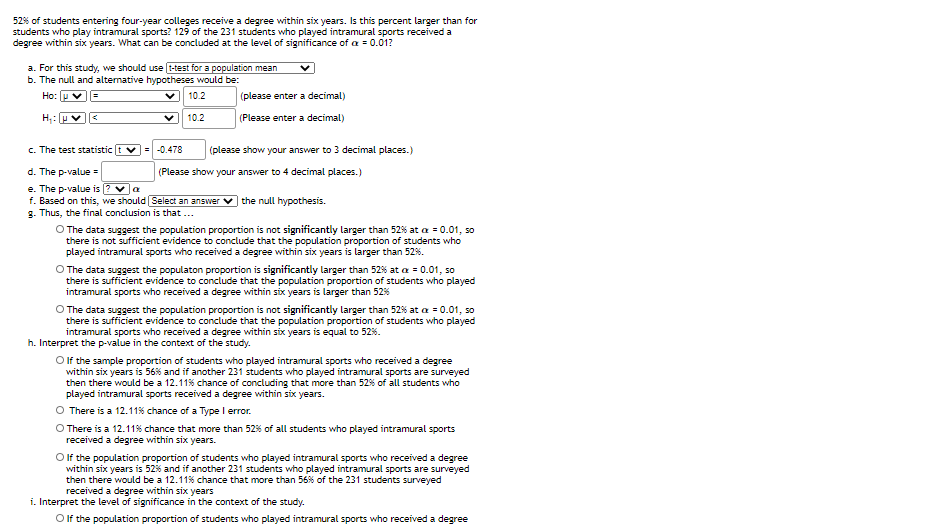52% of students entering four-year colleges receive a degree within six years. Is this percent larger than for students who play intramural sports? 129 of the 231 students who played intramural sports received a degree within six years. What can be concluded at the level of significance of a = 0.01? a. For this study, we should use t-test for a population mean b. The null and altemative hypotheses would be: Но: 10.2 (please enter a decimal) H;: P 10.2 (Please enter a decímal) c. The test statistic tv = -0.478 |(please show your answer to 3 decimal places.) d. The p-value = (Please show your answer to 4 decimal places.) e. The p-value is f. Based on this, we should Select an answer v the null hypothesis. g. Thus, the final conclusion is that .. O The data suggest the population proportion is not significantly larger than 52% at a = 0.01, so there is not sufficient evidence to conclude that the population proportion of students who played intramural sports who received a degree within six years is larger than 52%. O The data suggest the populaton proportion is significantly larger than 52% at a = 0.01, so there is sufficient evidence to conclude that the population proportion of students who played intramural sports who received a degree within six years is larger than 52% O The data suggest the population proportion is not significantly larger than 52% at a = 0.01, so there is sufficient evidence to conclude that the population proportion of students who played intramural sports who received a degree within six years is equal to 52%. h. Interpret the p-value in the context of the study. Olf the sample proportion of students who played intramural sports who received a degree within six years is 56% and if another 231 students who played intramural sports are surveyed then there would be a 12.11% chance of concluding that more than 52% of all students who played intramural sports received a degree within six years. There is a 12.11% chance of a Type I error. O There is a 12.11% chance that more than 52% of all students who played intramural sports received a degree within six years. Oif the population proportion of students who played intramural sports who received a degree within six years is 52% and if another 231 students who played intramural sports are surveyed then there would be a 12.11% chance that more than 56% of the 231 students surveyed received a degree within six years i. Interpret the level of significance in the context of the study.
Family of Curves
A family of curves is a group of curves that are each described by a parametrization in which one or more variables are parameters. In general, the parameters have more complexity on the assembly of the curve than an ordinary linear transformation. These families appear commonly in the solution of differential equations. When a constant of integration is added, it is normally modified algebraically until it no longer replicates a plain linear transformation. The order of a differential equation depends on how many uncertain variables appear in the corresponding curve. The order of the differential equation acquired is two if two unknown variables exist in an equation belonging to this family.
XZ Plane
In order to understand XZ plane, it's helpful to understand two-dimensional and three-dimensional spaces. To plot a point on a plane, two numbers are needed, and these two numbers in the plane can be represented as an ordered pair (a,b) where a and b are real numbers and a is the horizontal coordinate and b is the vertical coordinate. This type of plane is called two-dimensional and it contains two perpendicular axes, the horizontal axis, and the vertical axis.
Euclidean Geometry
Geometry is the branch of mathematics that deals with flat surfaces like lines, angles, points, two-dimensional figures, etc. In Euclidean geometry, one studies the geometrical shapes that rely on different theorems and axioms. This (pure mathematics) geometry was introduced by the Greek mathematician Euclid, and that is why it is called Euclidean geometry. Euclid explained this in his book named 'elements'. Euclid's method in Euclidean geometry involves handling a small group of innately captivate axioms and incorporating many of these other propositions. The elements written by Euclid are the fundamentals for the study of geometry from a modern mathematical perspective. Elements comprise Euclidean theories, postulates, axioms, construction, and mathematical proofs of propositions.
Lines and Angles
In a two-dimensional plane, a line is simply a figure that joins two points. Usually, lines are used for presenting objects that are straight in shape and have minimal depth or width.
please answer: D,E, F

Trending now
This is a popular solution!
Step by step
Solved in 2 steps









